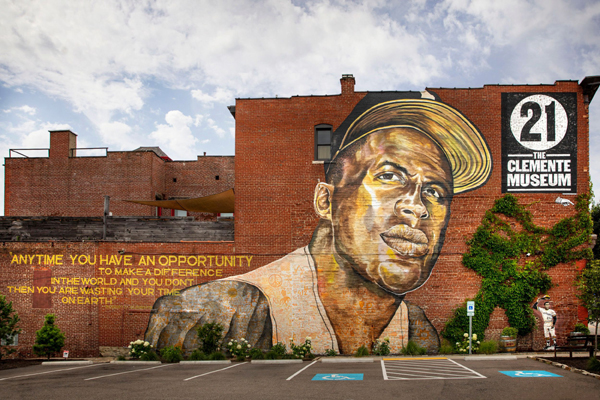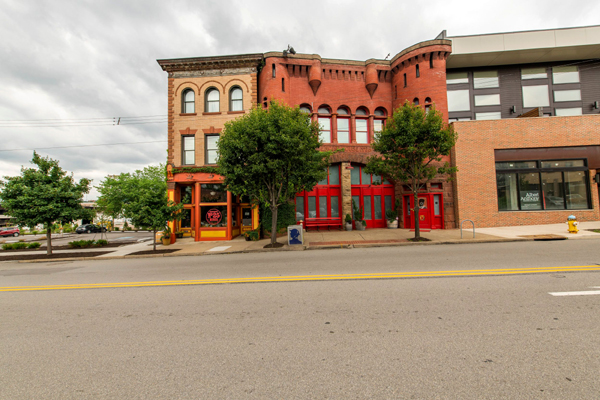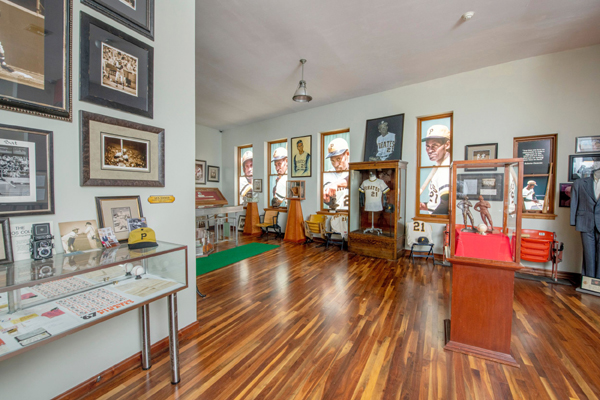The Clemente Museum
This article was written by Thomas Kern
This article was published in ¡Arriba! The Heroic Life of Roberto Clemente (2022)
“My mother and father never taught me to hate anyone, or to dislike anyone because of their race or color.…I don’t believe in color. I believe in people.” – Roberto Clemente Walker

Images courtesy of The Clemente Museum.
The establishment of the Clemente Museum in the Lawrenceville neighborhood adjoining downtown Pittsburgh was the brainchild of local photographer Duane Rieder. Clemente played his entire major-league career in Pittsburgh and died tragically in an airplane crash on December 31, 1972. One of baseball’s greatest humanitarians, he was organizing relief supplies for earthquake-torn Nicaragua when the plane he had hired to fly supplies to Managua on New Year’s Eve crashed into the waters off Puerto Rico’s north coast. All five people on the plane, including Clemente, perished. Clemente’s remains were never found.
During his 18-year playing career with the Pirates, Clemente was always admired, yet sometimes misunderstood because of his reserved, almost aloof demeanor. But his Hall of Fame career – which included exactly 3,000 hits, 12 Gold Gloves, 15 All-Star Games, and a postseason role in helping lead the Pirates to World Series championships in 1960 and 1971 – made for an unrivaled legacy that his selfless commitment to those less fortunate and the sacrifice of his own life even further solidified.
Few great sports figures have a museum to extol their legacy, but in Rieder’s view, the Clemente Museum seemed a natural addition to Pittsburgh’s cultural scene.
The fortuitous convergence of events that shaped the museum’s creation have established it as a fitting legacy to Clemente and a beacon for those wishing to learn more about and honor the Great Roberto. Major-league teams visiting Pittsburgh and the Pirates and other civic organizations have made the museum a focal point for social and cultural events.
The story of the museum begins in the early 1990s, when local entrepreneur Duane Rieder’s photography business needed a place to grow. His career began while he was in art school, and he officially opened a business in 1986. The 12,000-square-foot Lawrenceville firehouse, built in 1896, closed its doors in 1972 and was scheduled for demolition. For Rieder, it was an ideal setting for his work. Why Lawrenceville? The area had suffered from years of downturn following the city’s industrial decline. Local efforts took shape in the 1990s to attract new businesses to the neighborhood. According to Rieder, “I was one of the first persons to go to Lawrenceville [to relocate a business]. They wanted me to come in and be a sort of role model for what it could be. I opened up officially in 1996, at the beginning of the movement.”1
The derelict firehouse offered a sizable ground floor for photo shoots (where the bays for the fire engines had been) and an upstairs that could serve as a studio. Rieder could stage the renovations to the building over time to affordably upgrade the rundown structure. In sum, Engine House 25 at 3339 Penn Avenue was ideal for the new Rieder studio.

Although it was not on Rieder’s radar at the time, several quirks made it seem preordained that the firehouse should host the Clemente Museum. According to Rieder, “The walls are 21 inches thick in the building. There’s a steel beam upstairs from Carnegie Steel, stamped 1896, that’s 21 inches deep. It’s holding up a rubber roof, there’s no need for it to be that thick!”2
Alongside Rieder’s business interests was his love of sports. Photography would become a natural platform for him to combine the two for the native of St. Marys in northwestern Pennsylvania, about 120 miles from Pittsburgh. Rieder’s Pennsylvania ties and love of baseball forged a link to the team he grew up with – the 1960s and early 1970s Pirates led by Clemente, Vernon Law, Bill Mazeroski, and Willie Stargell. “We were poor and there were five of us, so we would play baseball all day long in the summer, rain or shine,” Rieder recalled. In 1971, he said, he got Clemente’s autograph along with a few others while at a Pirates game. Roberto was kind to him, Rieder remembered. Unfortunately, he no longer has that autograph. He was 11 when Clemente died in the plane crash. Like all baseball fans, and not just those in Pittsburgh, Rieder was devastated by Clemente’s untimely death at the age of 38. “I thought, he’s a professional athlete in great shape, surely he’ll just swim to shore.”3
In a rare move, the National Baseball Hall of Fame immediately inducted Clemente into the Hall in the summer of 1973, dispensing with the five-year wait embedded in its rules. His career accomplishments alone were compelling; the addition of Clemente’s character made his unusually timed induction an easy decision. Rieder later learned of another coincidence surrounding the engine house and Clemente when he learned that Lou Gehrig had stayed in the building one night in 1927.4 Apparently, Gehrig knew one of the local firefighters. The bond between Gehrig and Clemente was unique: the only two players elected to the Hall of Fame via special election.
Rieder first met the Clemente family – his widow, Vera, and his sons Luis, Roberto Jr., and Roberto Enrique – in the run-up to the 1994 All-Star Game scheduled to take place in Pittsburgh. In 1993 Rieder’s sports photography partnered with the Clemente family to produce a calendar as a memento for publication around the time of the 1994 All-Star Game in Pittsburgh. This was before he purchased Engine House 25 as his studio.
Rieder told the story as follows: “I was asked in 1993 to do a calendar full of pictures of Clemente. I went to his house in Puerto Rico and found that a lot of the photos of him had been damaged by water, from hurricanes and humidity. I retouched the photos for the family, preserving them, and was named his official archivist in 1996.”5 The trip to Puerto Rico led to the longstanding friendship with the Clementes and was, for Rieder, transformational. “When I hugged [Vera Clemente] for the first time, it was like I was hugging an angel, and from that moment on, I decided I wanted to help her.”6
Vera Clemente died in 2019, but the connection with the Clemente sons remains strong.
And the 1994 Clemente Calendar? “I’m a fan of old baseball,” said Rieder. “I love the look of the old sepia-toned images.”7 And so, the calendar brought that look to bear and won accolades.
The growing friendship between Rieder and the Clementes sharpened the photographer’s interest in and collection and preservation of artifacts and helped the Clementes restore and add to their own memorabilia. Phil Dorsey, a friend of the Clementes, died in 2002, and Rieder inherited much of his Clemente memorabilia. “I really got hooked on the photos of Roberto,” Rieder said. “I started buying and collecting negatives, collecting photos, to help Vera with her archive. And it just grew and grew.”8 Over time, Rieder bought signed articles and found documents from Roberto’s career in both the military and baseball.

Fast forward to 2006, when the Pirates hosted another All-Star Game. Thirty days before the game, Vera Clemente contacted Rieder to ask if the family could host an event at the Engine House. He recalled, “We hurried and slapped some paint on the interior and dressed it up in one month.… Vera Clemente was coming into town for the All-Star Game, and we wanted to show her the space and the collection.”9
Rieder decided to transform the ground floor from his studio into a showcase for his collection of memorabilia, eventually including a reproduction of the Forbes Field scoreboard. “Vera told me; it looks like a museum here. And the seed was planted there.”10
This party and his work with the Clemente family was the catalyst for Rieder to put together the Clemente Museum, and it opened on July 10, 2006. Rieder would be the first to admit that he had not started out years previously to open a museum. Instead, things just happened. His passion as a photographer became a catalyst for his sports interests, his relationship with the Clementes, and finally, a place to honor Roberto. “Without photography, none of this would be possible,” he said. “It has afforded me the opportunity to do all this, so when a client calls, that takes precedence.”11
As the years went by and while motivated by the circumstances surrounding Clemente’s passing, Rieder believed it important that the former ballplayer’s story be told to future generations as a reminder of what all might aspire to: excellence in one’s chosen profession for sure, but also a commitment to serve those less fortunate.
Not surprisingly, on the façade of the building next to the museum, where a mural painted by Kyle Holbrook stands, alongside is Roberto Clemente’s famous quote, “Any time you have an opportunity to make a difference in this world and you don’t, then you are wasting your time on Earth.”12 The story of Clemente’s life as told in the museum focuses equally on his humanitarianism alongside his baseball accomplishments.
For Rieder, this summed up his resolve to make the museum a reality. “Everybody knows how he died – helping people. He was doing that his whole life, for a lot of people in Pittsburgh and in Puerto Rico. I’m doing this because of the person he was, not because he was a great baseball player.”13
As plans took shape to house a museum at the Engine House, Rieder learned that the building was vacated on December 31, 1972. The day Clemente died. Another coincidence.
Vera Clemente served on the museum’s board for many years, and although the Clemente family is not formally involved in the museum’s operation, the special relationship the family has with Rieder in his capacity as executive director has allowed him to use Clemente’s name, image, and likeness. Rieder confers with the family on important matters, works closely with them on events designed to honor Roberto, and assists them in whatever capacity he can. The commitment is simple – to help tell the whole story about one of baseball’s all-time greats.
The museum’s collection, according to its website, “showcase[s] the world’s largest exhibited collection of baseball artifacts, works of art, literature, photographs, memorabilia, and related materials which focus on Roberto Clemente, his teammates, his personal life, and his humanitarian causes. Whether it is the Gold Gloves, Clemente’s ‘Momen’ bat, the Silver Slugger Award, the cleats, and home base from the ‘71 series or the name of his wife, Vera, scratched into a vase Roberto made for her, visitors to the Museum will leave knowing, more fully, what made Roberto Clemente a great man.”14
The Clemente family has loaned many pieces. These include several of Clemente’s Gold Gloves, his Silver Slugger Award bat from 1961, and the Hall of Fame plaque when Cooperstown corrected the inscription and gave the first one to the family. All else is either “from Rieder’s personal collection amassed over the years through purchase in auctions, trade, or from people who chose to donate their own Clemente artifacts.”15
A sad reminder of Clemente’s passing is “a propeller from the Douglas DC-7 plane, later determined to be overloaded, that crashed just after takeoff on Dec. 31, 1972. It was given to Rieder by the captain [of the Coast Guard ship] who retrieved it.”16
Emblematic of Rieder’s research and acquisition for the museum collections is the story about the Angel in the Outfield photograph. As one enters the museum, on the right is a floor-to-ceiling artwork depicting a Clemente catch in the outfield in spring training at Fort Myers in 1960. It is worth capturing the story in full as written by fellow photographer Al Tieleman:
The most impressive piece, which hangs just inside the front door, is a huge, quartered photograph of Clemente, jumping in the air, a ball just about to settle into his mitt. Very typical of the posed-action images photographers shot in the past, this image however, has a cloud formation that appears to give Clemente angel wings.
Rieder claims this image was part of a Pittsburgh newspaper collection which he purchased after it was discarded and retrieved from the trash. He explains the image was never published and was simply a series of several images a Sun Telegraph photographer took the same day. (There is a similar, smaller Mazeroski print displayed adjacent to this print with no cloud formation.) If this image was truly never published, I would consider it one of the all-time gaffes in photojournalism. If it was published, or even known to exist, well, that would be worse. The image is stunning, and borders on unbelievable because of its perfection: A beloved athlete, killed on a mercy mission, levitating perfectly in front of clouds that make him appear angelic.
(Here’s a comment from Alabama photographer Kevin Glackmeyer regarding the origin of the Clemente image noted in the blog post below. “The iconic, seemingly fabricated photograph of Roberto Clemente jumping for a fly ball at Terry Park is one of the most recognizable photos in baseball history but the story behind the photo is the incredible part. Clouds shaped like wings of an angel appear in the background behind Clemente. The negative of the photo was taken some time before 1960 at Terry Park [by Ed Salamony] of the Pittsburgh Post-Gazette. It was recovered from a trash container in 1991 in pieces and was reconstructed to display the amazingly well-timed photograph. The photo was stored in a box for seven years and then bought and displayed at the Clemente Museum in Pittsburgh where it remains today.”)17
The museum and its collections are open by appointment only and, assisted by several docents, hosts multiple tours daily. It can also be rented for special events. It is important to note that the museum is separate from both the nearby Western Pennsylvania Sports Museum at the Senator John Heinz History Center and other Clemente charities. Nor is it connected to the Clemente Foundation, based in the United States, or to Sports City, the recreation complex built by the Clemente family in his hometown of Carolina, Puerto Rico.
One other note. As a sidelight, Rieder has made wine for years. He noted that the wine came in handy as a punctation mark, “putting his work on the labels as a way to stand out to potential clients.”18
Rieder launched his winery, Engine House 25, in 2009 in the basement of the museum. It became a wine cellar and a place to host private gatherings. The wine is also sold to support the museum and local charities. It is yet another coincidence that Roberto Clemente preferred red wine, thanks to former Pirates player and trainer Tony Bartirome’s home winemaking that he shared with Clemente.
THOMAS E. KERN was born and raised in Southwest Pennsylvania. Listening to the mellifluous voices of Bob Prince and Jim Woods in his youth, how could one not become a lifelong Pirates fan? Ariba Roberto! He now lives in Silver Spring, Maryland, and sees the Nationals and Orioles as often as possible. He is a SABR member dating back to the mid-1980s. With a love and appreciation for Negro League baseball, he has written SABR bios for Leon Day, John Henry Lloyd, Willie Foster, Judy Johnson, Turkey Stearnes, Hilton Smith, Louis Santop, Andy Cooper, and Buck Ewing. Tom’s day job is in the field of transportation technology.
Sources
Unless otherwise noted, the basis for this article is several interviews with Duane Rieder, the museum’s executive director, and one of its docents, Gary Euler. The museum’s website has also provided content: https://clementemuseum.com/.
Two videos on YouTube capture tours by Duane Rieder of the museum:
Tour of Roberto Clemente Museum Part One – https://www.youtube.com/watch?v=xavubPgolnA&t=265s
Roberto Clemente Museum Tour Part Two – https://www.youtube.com/watch?v=JVJEAksztzk&t=8s
Notes
1 Will Schuster, “From Igloo to Igloo: Perspective: My Interview with Photographer Duane Rieder,” willschuster.blogspot.com, April 10, 2013. https://willschuster.blogspot.com/2013/04/perspective-my-interview-with.html, accessed November 18, 2021.
2 Kevin Creagh, “Off The Beaten Path – The Clemente Museum; One in a Series of Sporadically-Timed Articles Highlighting Hidden Pittsburgh gems,” City Life: The Point of Pittsburgh, March 5, 2015. https://thepointofpittsburgh.com/off-the-beaten-path-the-clemente-museum/, accessed November 18, 2021.
3 Creagh.
4 Christine H. O’Toole, “On the Fast Track: Duane Rieder,” Pittsburgh Magazine, October 12, 2010.
5 Schuster.
6 Joe Wojcik, “Ariba Roberto: Duane Rieder Pieces Together Memorabilia for the Clemente Museum,” Business Times (Pittsburgh), December 13, 2017.
7 O’Toole.
8 Wojcik.
9 Creagh.
10 Author interview with Duane Rieder, July 29, 2021.
11 Creagh.
12 There are multiple sources for Clemente’s famous quote.
13 Jennifer Baron, “Cleveland’s The Plain Dealer Scores a Home Run at Pittsburgh’s Clemente Museum,” Pittsburgh in the News, April 12, 2016.
14 Clemente Museum, https://clementemuseum.com/museum/, accessed October 24, 2021.
15 Creagh.
16 Baron.
17 Al Tieleman, “Angel in the Outfield,” http://altielemans.com/blog/angel-in-the-outfield, accessed October 24, 2021.
18 Schuster.


